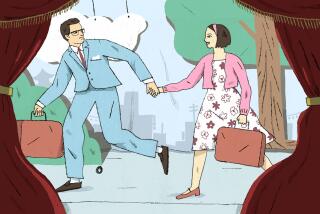After the Reunion by Rona Jaffe (Delacorte: $17.95; 336 pp.)
- Share via
“We were supposed to be perfect ladies, virgins, compliant hypocrites; and the future wives of Harvard men . . .” reminisces Emily Buchman, one of four members of Radcliffe’s Class of ’57 whom Rona Jaffe depicts in “After the Reunion.” This novel, the sequel to “Class Reunion” (1979), shows the affluent quartet immersed in romantic and domestic crises in the 1980s. They are also trying to outgrow the repressive social and moral code demurely obeyed by most Radcliffe women 30 years earlier.
During her college days, Emily aspired to be a doctor. After being told to marry one instead, she wed dermatologist Ken Buchman, moved to Beverly Hills and had two children. Unfortunately, Emily’s outwardly idyllic existence is a farce. Ken--who furtively snorts cocaine--brow beats her relentlessly, her children are unaffectionate, and servile Emily tolerates the abuse of all three. When her marriage disintegrates, she establishes a thriving cookie-baking business, then vaults to entrepreneurial fame.
Daphne “Golden Girl” Caldwell suppresses her discontent to avoid irritating her husband. Richard Caldwell usually rebuffs anyone with flaws, so the retardation of their institutionalized daughter goes unmentioned, as does Daphne’s epilepsy and the other youngsters’ growing pains. Richard’s rigidity eventually destroys their teen-age son Jonathan, who hangs himself to escape the smothering artificiality of the Caldwell household. Daphne’s discovery of her husband’s infidelity finally compels her to choose between divorce or life with this callous philanderer.
Alexander, the bisexual spouse of magazine editor Chris English, is also unfaithful. Chris adores him nevertheless, stoically overlooking his liaisons and forgiving his sexual disinterest in her. Before long, intensifying frustrations cause her to eat voraciously and have an affair.
Chaste Cliffies criticized Annabel for her promiscuity at a time when such freewheeling conduct was unthinkable for women. Undaunted by their disapproval, she breezed through short-lived flings and a misguided marriage. Now a successful Manhattan boutique owner, Annabel continues to flit from one unsuitable young beau to another in her quest for love.
Rona Jaffe’s deft storytelling is irresistible. Even so, the novel disappoints because these women never attain self-reliance. They can at least scoff at 1950s Radcliffe courses like “Gracious Living,” yet all four still need the reassurance of masculine or societal attention, and they willingly suffer to secure it. For example, Emily readily undergoes a face lift after a publicist suggests that she could garner more media notices by emulating Joan Collins.
Emily muses that her generation yearned “to make the happy endings happen.” In “After the Reunion,” the endings are happy, albeit contrived and unrewarding.
More to Read
Sign up for our Book Club newsletter
Get the latest news, events and more from the Los Angeles Times Book Club, and help us get L.A. reading and talking.
You may occasionally receive promotional content from the Los Angeles Times.










